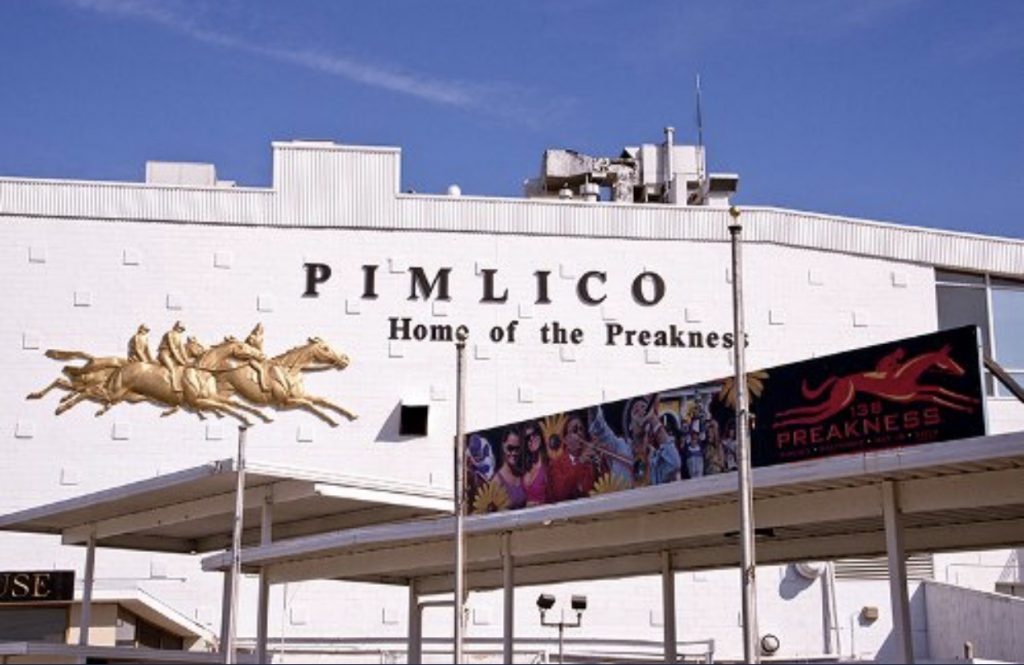
By: Margaret Ransom
This year marks the 144th Preakness Stakes, held once again at the historic Pimlico Race Course just outside of Baltimore. With many racing insiders calling for the race to be moved to the more modernized Laurel Park, located about 30 miles southwest, this may be the last year the second jewel of the Triple Crown (or certainly one of the last years) is at “Old Hilltop”, so maybe now is good time to look back at the race with the funny name held at a track where nobody is quite sure how it got its name to begin with.
So how did Pimlico get its name anyway? The word Pimlico has been loosely connected to Sir Walter Raleigh’s unsuccessful attempts at establishing English settlements the 1580s. Other historians maintain that the word Pimlico is derived from a local Native American tribe, the Minisi Tribe, who called their lands “Praquales” which means “quail woods.” The colt who won the first race at Pimlico was named Preakness, after the farm where he was born, located in “quail woods.”
Additionally, some have maintained that English settlers in Maryland named the area in honor of Olde Ben Pimlico’s Tavern in London. There is also a metro stop in London named Pimlico. How or why a connection exists remains a mystery.
The track is nicknamed “Old Hilltop” because of a small rise in the infield, which was leveled in 1938 and now hosts the popular Preakness Infield Festival.
Pimlico opened in 1870 and featured the first running of the $15,000 Dinner Party Stakes, which was an enormous purse for the time. Then Maryland Governor Oden Bowie had previously boasted at a dinner party in Sarasota, Florida, that Maryland would have a quality racetrack so the opening day date and stakes name was a realization of that proclamation.
Governor Bowie’s horse came in last in the 1873 renewal of the Dinner Party Stakes, but he still got to name what would become the second jewel in the Triple Crown, anointing the race the Preakness Stakes after the colt who won the inaugural Dinner Party Stakes at Pimlico’s opening in 1870. The Dinner Party Stakes is still run annually at Pimlico.
On October 24, 1877, the United States Congress shut down for a day, which compared to today was practically unheard of at the time, so members could attend a match race at Pimlico between the Kentucky Derby and Preakness champions, and an unknown gelding named Parole. Three horses made up the race that year.
Due to financial issues at Pimlico, The Preakness was run at Morris Park in New York in 1890 and was not run at all in 1891, 1892 and 1893. From 1894 through 1908, the Preakness was run at Gravesend Racetrack in Brooklyn and did not return to Baltimore until 1909.
Since 1969, the Preakness has been run on the third Saturday in May, two weeks after the Kentucky Derby, but that’s not always been the case. The Preakness has been run before the Derby 11 times, and on two of those 11 occasions the races were contested on the same day. The current order and spacing of the Triple Crown races has been in place since 1969, making this year the 50th anniversary of the two-week break between the Derby and Preakness Stakes. Though now in it’s 144th running, the Preakness is actually older than the Kentucky Derby. It was first run in 1873, which predates the Derby by two years, but since the Preakness wasn’t run from 1891 to 1893, this year marks the 144th running while this year marked the 145th Kentucky Derby.
Though the Maryland state flower is the Black Eyed Susan, the winner of the Preakness actually wears a blanket of Daisies or Viking Poms since Black Eyed Susans don’t bloom until at least June.
A total of 54 fillies have started in the Preakness Stakes with five winners, the most recent being Rachel Alexandra in 2009. No fillies will race in the Preakness this year. Seven geldings have won the Preakness, the last was Funny Cide in 2003. Alwaysmining represents the lone gelding in the field this year. Also, geldings were barred from the Preakness from 1920 through 1934.
In the last 28 years, just three Preakness winners did not also compete in the Kentucky Derby. This year will be the fourth in 29 years and the first time in 23 years the Derby winner did not make the trek to Baltimore.
The last time the top three finishers in the Kentucky Derby competed in the Preakness was 2013. This year also marks the first time in its 144-year history that none of the first four finishers in the Derby will not line up in Baltimore. Since 1991 only four Preakness winners did not compete in the Kentucky Derby first, Cloud Computing two years ago being the most recent. Louis Quatorze was the worst-finishing Derby horse to win the Preakness in 1996. This year none of the four Derby/Preakness runners finished worse than 14th (Bodexpress.)
The Trophy
The Preakness trophy, the Woodlawn Vase, is considered the most valuable trophy in sports. It was crafted in silver by Tiffany & Co. and had an estimated value of $1 million in 1983, which in today’s dollars amounts to more than than $4 million in replacement value. The vase is named the Woodlawn Vase because during the Civil War it was buried at Woodlawn Farm in Kentucky so as not to be discovered and melted into shot for Confederate Army soldiers.
Racehorse owner Thomas C. Clyde claimed possession of the Woodlawn Vase in 1904 and in 1917, Clyde presented the vase to the Maryland Jockey Club, for which he served as a director. It was added as the Preakness winning trophy that year. Winning owners previously maintained custody of the trophy for a year following the Preakness, but after Native Dancer’s win in 1953, Alfred Vanderbilt’s wife declined citing the value of the trophy, both financially and sentimentally. So now the original trophy is kept at the Baltimore Museum of Art and transported to the Pimlico each year escorted and guarded by Maryland Army National Guard Soldiers and Air National Guard Airmen in dress uniforms donning white gloves. It then rests temporarily in the cupola winner’s circle for the presentation ceremony each year.
Completely unique to the Preakness is the famed historic weather vane, a tradition since the Preakness’s return to Baltimore in 1909. The weather vane originally sat atop of the member’s clubhouse and when it was destroyed by fire in 1966, a replica of the building’s cupola was built to stand in the winner’s circle in the infield. According to the official Preakness site, “as soon as the Preakness winner has been declared, a painter climbs a ladder to the top and applies the colors of the victorious owner’s silks on the jockey and horse which are part of the weather vane.”
In addition to the winner painted on the weather vane, it is draped with a blanket of the traditional Black Eyed Susans.
The Preakness has been run at seven different distances:
1 ½ miles: 1873–1888, 1890
1 ¼ miles: 1889
1 1/16 miles: 1894–1900, 1908
1 mile and 70 yards: 1901–1907
1 mile: 1909, 1910
1 1/8 miles: 1911–1924
1 3⁄16 miles: 1925–present
The great Secretariat still owns the Preakness Stakes record of 1:53, set in 1973, but that mark didn’t come without some controversy. The Triple Crown winner was originally credited with a running time of 1:55, but two Daily Racing Form clockers had timed Secretariat’s Preakness in 1:53 2⁄5, which would be a new stakes record. A hearing was held soon after over the time discrepancy, where a video replay showed Secretariat reached the wire faster than 1971 wnner Canonero II, who held the stakes record. Instead of giving Secretariat the record, the Maryland Jockey Club decided to split the difference and make its official time that of Pimlico’s clocker, who had timed the race in 1:54 2⁄5.
Nearly 40 years later in 2012, the matter was finally resolved when the Maryland Racing Commission unanimously ruled to change Secretariat’s final time to 1:53 based on testimony and analysis of the race replays.
Hall of Fame jockey Eddie Arcaro still owns the jockey record for most winners ridden, while fellow Hall of Famer Pat Day has five. Of all the jockeys currently still active Kent Desormeaux and Victor Espinoza have the most wins with three each. Neither have a mount this year.
Robert Wyndham Walden saddled seven Preakness winners in the last years of the 19th century, including five straight from 1878 to 1882. Prominent Thoroughbred owner George Lorillard owned all five. In 2018, Triple Crown winner enabled fellow Hall of Famer Bob Baffert to join Walden with a seventh Preakness victory. Baffert sends out the morning line favorite in Improbable this year.
Hall of Famer D. Wayne Lukas has saddled a record 43 Preakness starters. Nick Zito (21), Baffert (19), Max Hirsch (19), Sunny Jim Fitzsimmons (18) and James Rowe (14) follow. Lukas is represented by longshot Market King this year.
The oldest living Preakness winner is 1997 hero Silver Charm, who is pensioned at Old Friends Farm in Kentucky.
Always check with Past the Wire for the latest horse racing news and more…..



